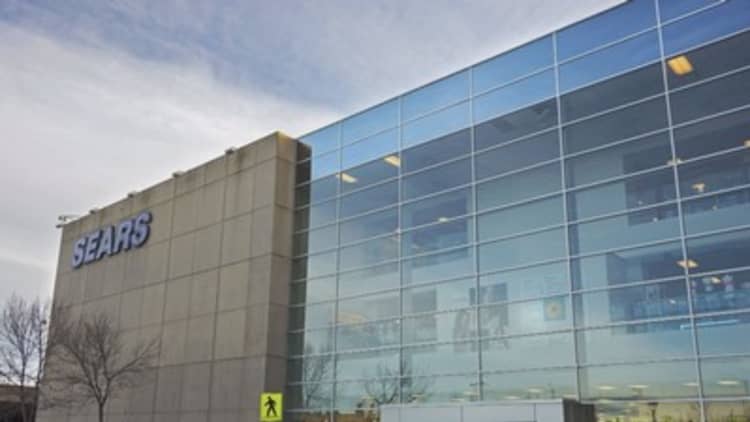Sears CEO Eddie Lampert is making his biggest push yet to avoid bankruptcy, with the company running out of time as a large debt payment hangs over its head next month.
Lampert's hedge fund, ESL Investments, is proposing a way to restructure the struggling department store chain's liabilities, in addition to asking Sears' board to sell off roughly $1.75 billion worth of assets. This would reduce the retailer's total debt by nearly 80 percent to $1.24 billion, according to the documents filed Monday with the Securities and Exchange Commission.
Sears would also sell about $1.5 billion worth of real estate, much of which has been used as collateral in the past to generate liquidity, as part of the proposal. Some of the stores in such a transaction would be leased back to Sears, the filing said. Sears operated 866 stores under both its namesake brand and Kmart as of Aug. 4.

Lampert, who has a controlling ownership stake in Sears, personally owns roughly 31 percent of the retailer's shares outstanding, while ESL owns about 19 percent. The CEO has been steadily stripping out assets to keep the company afloat over the past several years. It's unclear whether Sears' current debtholders will continue to support these efforts, which have amounted effectively to restructuring outside of formal bankruptcy proceedings. Those debtholders must be convinced that Sears is worth more than the value of its assets — namely its real estate and its brands — despite its constant losses. The longer Sears waits to file for bankruptcy, the more the value of its assets arguably decline.
"Indeed, had Sears been owned by anyone else it would have likely long since gone under," said Neil Saunders, managing director at GlobalData Retail.
The proposal comes as Sears risks breaching its debt covenants and faces a significant payment of $134 million on Oct. 15. ESL's efforts laid out earlier this year to infuse cash into the company by selling its storied Kenmore appliance brand and its home improvement business have been held up by a special committee of the board of directors. Meantime, after years of selling off certain assets, including Craftsman, and real estate to keep to the company afloat, the teetering retailer is at its final steps in what it can offer lenders as collateral in a restructuring.
Some don't think Lampert's plans will stave off further restructuring, forever.
"Even if the restructuring as proposed — which Fitch views as challenging to execute — goes through, the company will continue to require significant liquidity injection given operating headwinds," Fitch Ratings analyst Monica Aggawrwal said in a note to clients Monday afternoon.
Fitch said it anticipates Sears' annual liquidity needs to amount to more than $600 million per year, with EBITDA expected to remain negative, in the $500 million to $600 million range, with ongoing cash interest expense of $88 million in addition to "any modest working capital/capex needs."
To help manage its liabilities, Sears has been working with investment bank , people familiar with the talks told CNBC. The boutique bank has a specialty in restructuring and bankruptcies, including managing the Toys R Us liquidation.
Lazard declined to comment.

In a letter to the special committee earlier this year, Lampert asked the board to reach out to Sears' debtholders to assess their views on restructuring.
It's still unclear if debtholders would agree to ESL's latest proposal, but the hedge fund said Monday that it would be best to accomplish these things "as a going concern, rather than alternatives that would substantially reduce, if not completely eliminate, value for shareholders."
ESL's goal is to have the department store chain refinance $1.1 billion of debt coming due within the next two years. Sears has about $5.5 billion in debt today.
"ESL's proposal is designed to help create sufficient runway for Sears Holdings to continue its transformation and return to profitability for the benefit of its many stakeholders," ESL President Kunal S. Kamlani said in an email to CNBC.
He said the board should either work with the hedge fund or "offer reasonable alternatives."
Sears earlier this month reported a net loss of $508 million for the quarter, as sales tumbled by a double-digit percentage. Its adjusted loss before interest, taxes, depreciation and amortization widened to $112 million, compared with a loss of $66 million during the same quarter a year prior. Sales at stores open at least 12 months also fell 3.9 percent during the second quarter.
At that time, Lampert rang the alarm bells about potential dire outcomes should the company not restructure its debt load or secure special committee approval for looming asset sales.
"Given the pace and the results so far from our efforts to monetize assets, it is imperative that the company reduce debt, adjust its debt maturity profile and eliminate the associated cash interest obligations," wrote Lampert. "We continue to believe that it is in the best interests of all our stakeholders to accomplish this as a going concern, rather than alternatives that could result in significant reductions in value."
Sears appointed a special committee earlier this year to balance out the potential conflict of interest inherent in ESL's bid for Kenmore and the home improvement business. The committee has frustrated Lampert with its slow pace, a source familiar with the situation has told CNBC.
The committee has been talking to other potential buyers to see if it can fetch a higher offer, that source added.
The special committee's conundrum is amplified by the predicament faced by the Pension Benefit Guaranty Corp., the federal government's oversight organization that guarantees individuals' pensions and has a lien on Kenmore's intellectual property.
Sears shares, which years ago traded above $140, recently hit an all-time low of $1.07. The stock initially soared more than 20 percent Monday morning but was recently down more than 7 percent at around $1.18. Sears' market cap is just about $131 million today.



